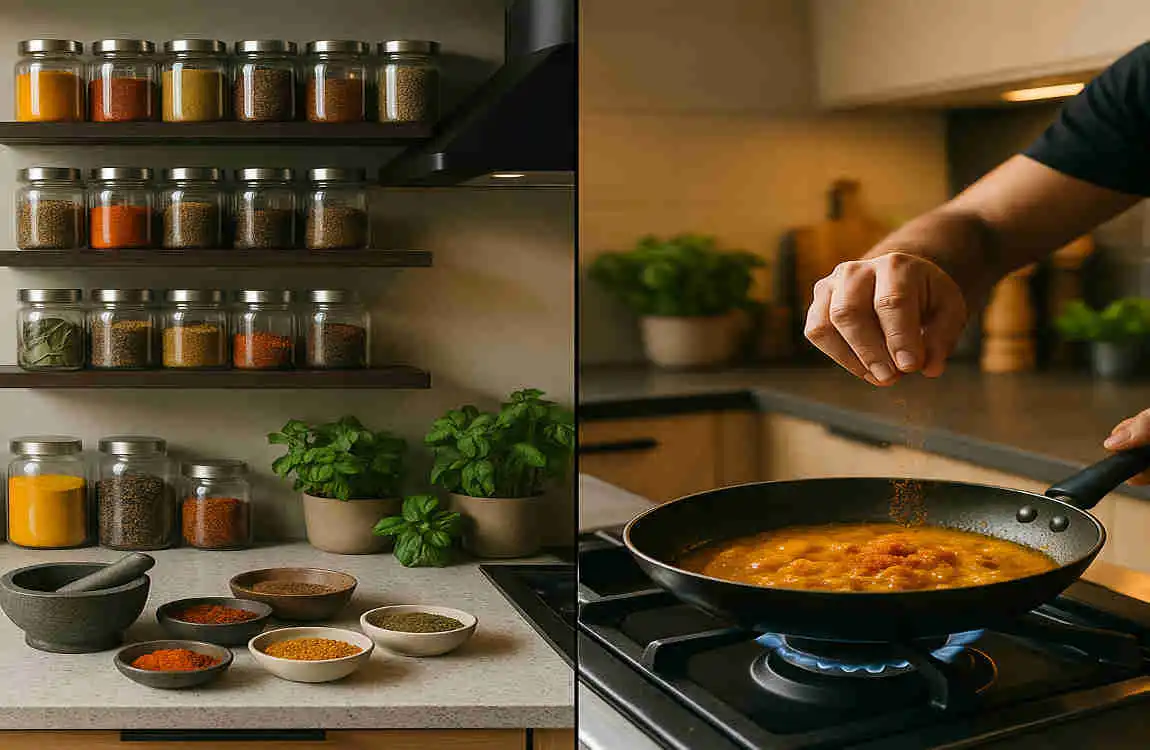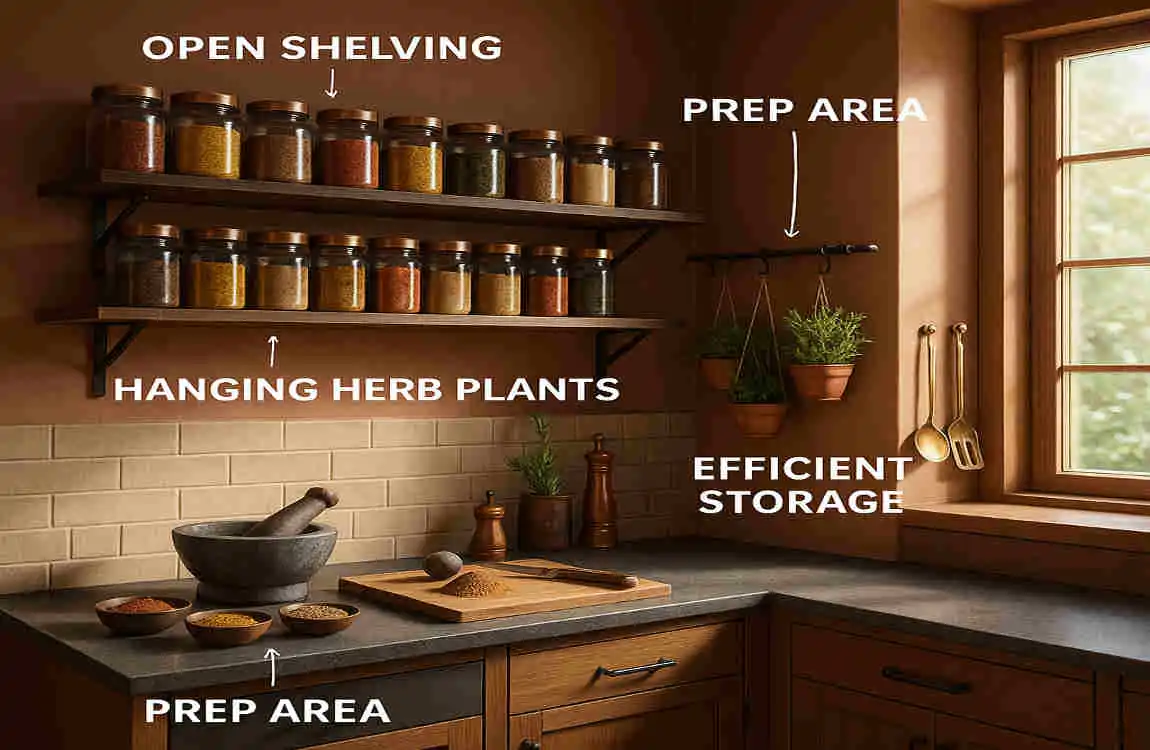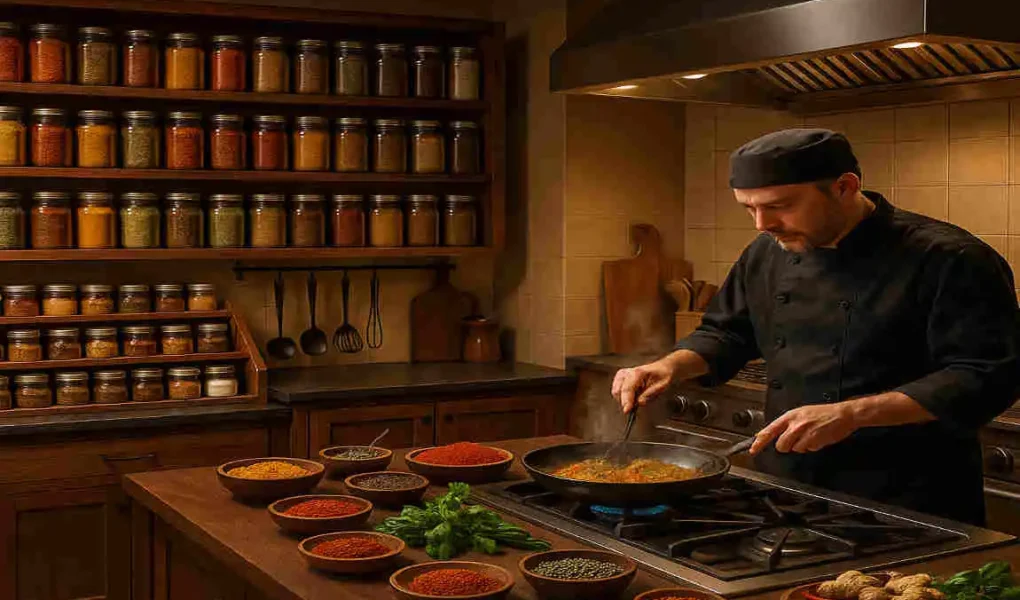In today’s world, kitchens are evolving far beyond their traditional roles. Modern kitchen trends emphasize specialized spaces designed to enhance cooking experiences and meet diverse culinary needs. One such innovation gaining attention is the spice kitchen—a concept many home cooks and food lovers are curious about.
You might have wondered, “What’s a spice kitchen?” or why some homes feature separate cooking areas specifically for spices and aromatic dishes. This interest stems from the desire to manage strong odors, maintain a clean central kitchen, and accommodate specific cooking styles that utilize intense flavors and spices.
Whether you’re a passionate cook, someone who enjoys hosting dinners, or love experimenting with bold flavors, understanding spice kitchens could transform your culinary space and daily routine.
We’ll cover everything from the basics and benefits to design tips, maintenance advice, and even how spice kitchens compare to outdoor and regular kitchens. By the end, you’ll have a handy guide to help you decide if a spice kitchen is right for your home!
What Is a Spice Kitchen?
A spice kitchen is a dedicated cooking area designed to handle the preparation of dishes that involve strong spices, aromas, and traditional cooking methods often seen in many Asian and Middle Eastern homes.
Unlike a regular kitchen, which serves all cooking purposes, a spice kitchen focuses on managing the intense smells and mess that come with cooking aromatic dishes such as curries, stir-fries, and other spice-heavy recipes.
Historical and Cultural Roots
The concept of a spice kitchen has its roots in various cultures, particularly in South Asia, Southeast Asia, and the Middle East. In these regions, cooking often involves a variety of spices like cumin, turmeric, cardamom, and chili—ingredients that not only add flavor but also release potent aromas that can linger.
Traditionally, families built separate cooking areas to keep these strong smells away from living spaces. These kitchens also helped manage the heavy smoke and heat produced by traditional cooking equipment, such as wood-fired stoves or chulhas.
Key Differences from a Traditional Kitchen
- Ventilation: Spice kitchens often feature enhanced ventilation systems to remove smoke and odors quickly.
- Layout: They might be smaller, more utilitarian spaces adjacent to or separate from the central kitchen.
- Materials: Surfaces and walls are made of materials designed to withstand heat, stains, and pungent spices.
- Appliances: Often equipped with more burners or traditional stoves suitable for high-heat cooking.
In short, a spice kitchen is a functional and practical space designed to make spicy cooking easier, cleaner, and more enjoyable.
Why Have a Spice Kitchen? Benefits and Uses

If you love cooking with bold flavors or come from a culture that uses spices heavily, a spice kitchen can be a game-changer. Here’s why:
Managing Strong Aromas
One of the biggest challenges when cooking spicy or aromatic dishes is the lingering smell. These smells can cling to walls, fabrics, and furniture in a regular kitchen or living space.
A spice kitchen, with its dedicated ventilation and isolated cooking area, helps contain these smells. This means your living spaces stay fresh, and the odors don’t overpower your home.
Avoiding Cross-Contamination of Flavors
When you cook different cuisines or dishes side-by-side, flavors can mix unintentionally. A spice kitchen prevents this by allowing you to separate the preparation of intense dishes from milder ones.
Imagine preparing a delicate dessert or salad in your central kitchen while your spice kitchen handles a fiery curry, ensuring no cross-contamination of flavors.
Maintaining Cleanliness and Order
Cooking with spices often involves oils, powders, and vibrant sauces that can stain counters and walls. A spice kitchen uses materials and finishes that are easy to clean and resistant to stains.
This keeps the central kitchen looking neat and reduces the stress of deep cleaning after heavy cooking sessions.
Practicality for Extensive Cooking and Hospitality
If you enjoy hosting large gatherings or cooking multiple dishes at once, a spice kitchen provides extra burners, workspaces, and storage. This allows you to multitask efficiently without clutter.
Specialized Cuisines That Benefit
Certain cooking styles benefit greatly from spice kitchens, such as:
- Indian cuisine is renowned for its intricate spice blends and robust cooking techniques.
- Southeast Asian dishes: Using ingredients like lemongrass, galangal, and chili that create strong smells.
- Middle Eastern meals: Featuring spices like saffron, sumac, and za’atar.
Designing Your Spice Kitchen: Key Elements to Consider

Creating a spice kitchen requires thoughtful planning to strike a balance between functionality, safety, and comfort.
Space and Location
A spice kitchen can be:
- A separate room adjacent to the central kitchen.
- A partitioned section within your existing kitchen.
- An outdoor extension if space allows.
Choose a location that has easy access to your central kitchen but helps contain smells and heat.
Ventilation Systems
Good ventilation is crucial. Consider:
- Powerful exhaust fans or hoods that remove smoke and fumes instantly.
- Windows or vents positioned to maximize airflow.
- Air purifiers or filters to reduce airborne particles.
Materials and Finishes
Select surfaces that stand up to heat, moisture, and stains:
| Material | Pros | Cons |
|---|---|---|
| Ceramic Tiles | Easy to clean, heat resistant | Can crack if heavy impact |
| Stainless Steel | Durable, hygienic, heat resistant | Can show fingerprints |
| Stone (Granite/Quartz) | Stylish, strong, easy maintenance | Can be expensive |
Appliances
Typical spice kitchen appliances include:
- Extra burners or stoves, sometimes traditional chulhas.
- Large pots and pans for batch cooking.
- Tandoor ovens or woks, depending on cuisine.
Storage Solutions
Separate storage for spices and ingredients is key. Think spice racks, airtight containers, and shelves designed to keep ingredients fresh and accessible.
Work Surfaces
Choose countertops that clean easily and resist staining. Smooth finishes help wipe away oily residues quickly.
Safety Considerations
Spice kitchens often involve high heat and open flames, so:
- Install fire-resistant materials.
- Keep fire extinguishers nearby.
- Use childproof locks if needed.
Spice Kitchen vs Outdoor Kitchen vs Regular Kitchen: What’s the Difference?
Understanding these kitchen types helps you pick what works best for your home.
| Kitchen Type | Features | Pros | Cons |
|---|---|---|---|
| Spice Kitchen | Separate indoor space for spice-heavy cooking | Controls odors, efficient for spicy dishes | Requires space, ventilation needs |
| Outdoor Kitchen | Cooking area outside the home | Keeps smells out, great for social cooking | Weather-dependent, maintenance |
| Regular Kitchen | General cooking space indoors | Central location, versatile | Odors linger, may get messy |
When to Choose a Spice Kitchen?
- If your cooking often involves strong-smelling spices.
- When you want to keep your central kitchen clean and fresh.
- If you regularly cook large meals or diverse cuisines.
When Outdoor Kitchens Work
- Perfect for grilling, barbecues, and social events.
- Ideal for those with sufficient outdoor space and mild weather.
How to Incorporate a Spice Kitchen into Your Home
Consider adding a spice kitchen. Here are some practical tips:
Retrofitting Existing Kitchens
- Use partition walls or sliding doors to section off an area.
- Install powerful exhaust fans to manage aromas.
- Add dedicated counters for spice-heavy prep.
Budget Considerations
- Simple upgrades include better ventilation and storage.
- Complete builds involve construction and appliance installation, which are more costly.
Professional Help vs DIY
- Hiring experts ensures safety and proper installation.
- DIY is possible for slight changes but requires careful planning.
Space-Saving Ideas
- Narrow, vertical spice racks.
- Foldable counters or multi-use surfaces.
- Compact appliances designed for small spaces.
Design Inspiration
- Use warm colors and natural materials that reflect the origins of spices.
- Incorporate open shelving for easy access to spices.
- Include plenty of lighting for detailed prep work.
Maintenance and Upkeep of a Spice Kitchen
Keeping your spice kitchen in top shape ensures it stays functional and pleasant.
Daily Cleaning
- Wipe surfaces with mild detergents to remove oils.
- Clean spills immediately to prevent staining.
- Empty trash regularly to avoid odors.
Periodic Deep Cleaning
- Scrub tiles and grout to prevent buildup.
- Clean exhaust fans and filters to maintain airflow.
- Check appliances for wear and safety.
Ventilation Care
- Replace or clean filters regularly.
- Inspect fans for noise or reduced efficiency.
Spice Storage
- Use airtight containers to keep spices fresh.
- Label containers to avoid confusion.
- Organize spices by frequency of use.
Conclusion: Is a Spice Kitchen Right for You?
Now that you know what a spice kitchen is and its many benefits, it’s time to reflect on your cooking habits and home space.
Ask yourself:
- Do you often cook with strong spices that leave lingering smells?
- Would a separate cooking space improve your kitchen’s cleanliness?
- Do you have the space and budget for a spice kitchen?
If you answered yes, a spice kitchen could be an excellent addition to your home. It not only enhances your cooking experience but also helps maintain a fresh, organized living space.
You may also read (laminate flooring expansion what homeowners need to know).


